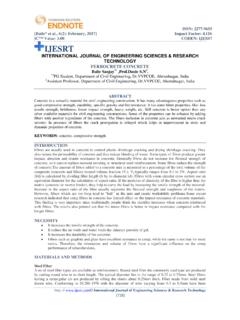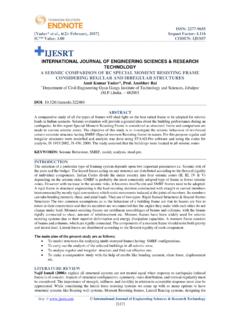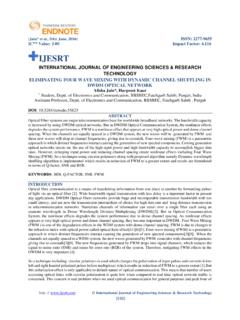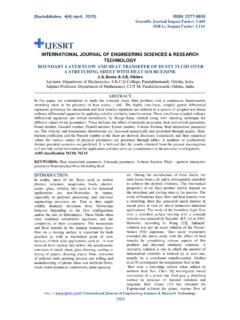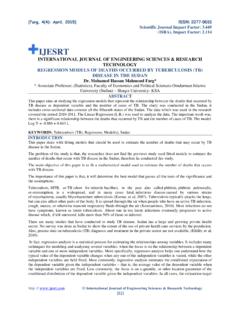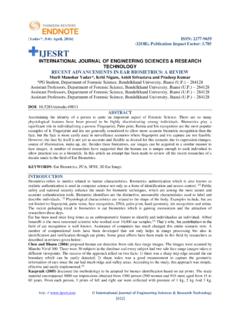Transcription of IJESRT
1 [Gehlod,1(10): December, 2012] ISSN: 2277-9655 Scientific Journal Impact Factor: (ISRA), Impact Factor: http: // International Journal of Engineering Sciences & Research Technology [663] IJESRT INTERNATIONAL JOURNAL OF ENGINEERING SCIENCES & RESEARCH TECHNOLOGY Challenges in Software Development on Cloud Platform Lalit Gehlod* * Department of Computer Engineering, Institute of Engineering and Technology, Indore ABSTRACT Enterprise application development with traditional software has always been too complex, too slow, and too expensive. A new model called cloud computing has emerged over the last decade to address these problems.
2 Applications that run in the cloud are delivered as a service so companies don t have to buy and maintain hardware and software to run them or huge IT teams to manage and maintain complicated deployments. More recently, Most Software Industry opened up cloud infrastructure so everyone can use it for custom application development. With cloud platform, you can build any business application and run it on cloud servers. The application development world is beating a path to the cloud platform and its unlimited power to innovate. This paper analyzes challenges of software development process on cloud computing platform to develop quality software (SW).
3 KEYWORDS: Application Development, Cloud Computing, Cloud Provider, Quality Software. Introduction Cloud computing generally describes a method to supplement, consume and deliver IT services over the Internet [2]-[3]. Web-based network resources, software and data services are shared under multi-tenancy and provided on-demand to customers. It is this central tenet of sharing and the standardization it implies that is the enabler of cloud computing core benefits. Cloud computing providers can amortize their costs across many clients and pass these savings on to them.
4 This paradigm shift in computing infrastructure was a logical by product and consequence of the ease-of-access to remote and virtual computing sites provided by the Internet. Cloud computing may also be able to resolve the traditional tensions created by software development projects governance versus agility, consistency versus rapid adoption, and quality versus time to- market by delivering the flexible infrastructure required to get development projects off the ground quickly, and the tools to enable constructive interaction between in-house Stakeholders and the outsourced development team.
5 Building Applications on Cloud Platforms is much faster compared to Traditional On-Premise Applications. Cloud Platforms have Built-In Database, security, workflow, user interface, and other tools that help in building powerful business apps, mobile apps, and Web sites. Since the entire Application is hosted on cloud, customers need not worry about IT Infrastructure, Upgrades, updates, uptime and backups. Cloud Computing has been envisioned as the next generation architecture of IT Enterprise. In contrast to traditional solutions, where the IT services are under proper physical, logical and personnel controls, Cloud Computing moves the application software and databases to the large data canters, where the management of the data and services may not be fully trustworthy.
6 Fig. 1 Cloud Computing [Gehlod,1(10): December, 2012] ISSN: 2277-9655 Scientific Journal Impact Factor: (ISRA), Impact Factor: http: // International Journal of Engineering Sciences & Research Technology [664] Cloud computing differs from the classic client-server model by providing applications from a server that are executed and managed by a client s web browser, with no installed client version of an application required. Centralization gives cloud service providers complete control over the versions of the browser-based applications provided to clients, which removes the need for version Any computer or web-friendly device connected to the Internet may access the same pool of computing power, applications, and files in a cloud-computing environment as shown in figure 1.
7 Users may remotely store and access personal files such as music, pictures, videos, and bookmarks; play games; or do word processing on a remote server. Data is centrally stored, so the user does not need to carry a storage medium such as a DVD or thumb drive. Desktop applications that connect to internet-host email providers may be considered cloud applications, including web-based Gmail, Hotmail, or Yahoo! email services. Cloud computing technologies are regarded by some analysts as a technological paper analyzes impact of cloud computing platform on software development process to develop quality software (SW).
8 Economies of all software industries depend on quality SW and SW cost is more than hardware (HW) cost. Moreover because of the involvement of many parties, SW development is inherently a complex process and most of the SW project fails because of lack of communication and coordination between all the parties involved. The main theme of this paper is that the prevalent SW development process models should involve the cloud provider in every steps of decision making in software development life cycle to make the software project a success In Section II, background literature on software engineering with cloud computing is surveyed.
9 How the software developer is coping with the changing trend of application development with Web protocols and application deployment over the cloud is reported. In Section III, challenges of cloud computing platform for software engineering is analyzed. In Section IV a process model which incorporates interaction with cloud provider is proposed and analyzed. Section V concludes the paper. Literature Survey Enterprise Application Development Old and New The old way: application-building that s slow and inefficient. Over the years, the traditional way of creating and running business applications has become overly complex and umbersome.
10 There are too many moving parts to buy, install, configure, and maintain including hardware and software. Plus, the entire infrastructure requires constant maintenance to keep it working smoothly. This overhead burden creates barriers to productivity in custom application development. Computing environment complexity means that every little change can trigger repercussions throughout the organization. That setup significantly reduces overall IT responsiveness, impairing the ability of a company to address constantly changing business needs. Instead, enterprise application development precedes at a glacial pace, with long backlogs a fact of life.
